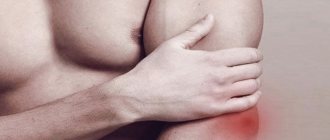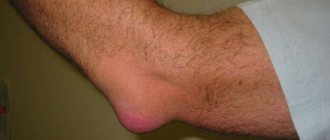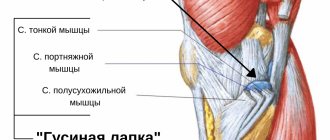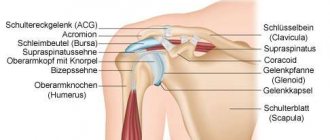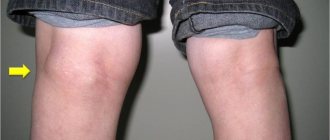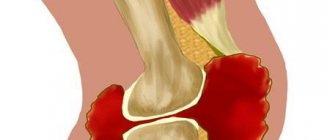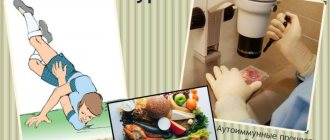What is bursitis
A special capsule that surrounds the joint is the bursa (“bursa” - translated from Latin as “bag”). This is a small cavity that looks like a pocket or bag and surrounds each joint, protecting it from injury and external influences. It consists of dense fibers of connective tissue, ligaments, tendons, has a dense outer covering and an inner layer of cells that produce a special fluid (synovial). This fluid serves as an internal lubricant of the joint, ensures smooth gliding in it, nourishes and moisturizes joint tissues that do not have their own blood vessels.
Bursitis is an inflammatory process in the joint capsule, in which the production of synovial fluid increases in it. This leads to swelling of the joint and pain when moving in it. Inflammation can be acute or chronic, and it occurs in different joints of the body. Most often - in those that experience heavy loads: shoulder, elbow, wrist, knee, ankle.
There is acute bursitis - it develops rapidly within a few days after an injury or infection. With frequent repeated injuries or without treatment, joint bursitis becomes chronic. Frequent (but less intense in symptoms) relapses and deterioration in joint mobility occur. The bursa thickens, and the villi of the inner layer can grow together, causing salt deposits to form in the joint.
Without treatment, acute bursitis can result in suppuration in the joint and spillage of pus into the subcutaneous fat in the area adjacent to the joint.
How to treat bursitis
Treatment of bursitis directly depends on its form. It can be conservative or surgical, or a combination of these methods. The entire treatment period takes from 2 to 5 weeks. The basic principles of treatment are rest, medications, physiotherapy and exercise therapy with elements of massage. Let's briefly look at each aspect.
- Joint immobilization
First of all, it is important to protect the inflamed area first so as not to irritate it further and cause additional friction. Temporary immobilization helps this. Immobilization should not be too long, otherwise it may lead to contractures. Typically the following fixation is used:
- pressure bandage with an elastic bandage;
- soft or hard bandage
- splint, light plaster
We must remember that the joint must be developed! But it is necessary to start developing it only after consulting a doctor, carefully following all his recommendations so as not to aggravate the process.
- Compresses and ointments
Your doctor may prescribe topical compresses, gels, and ointments that reduce inflammation. The use of cooling ointments and gels, cold packs or ice helps to calm the inflamed bursa and reduce pain.
Warning:
Do not place cold applications or ice directly on the skin, as frostbite may occur, and do not use them for more than 15 minutes. Cold lotions and compresses can be repeated every hour. Cryotherapy should be used only as prescribed by a doctor!
- Anti-inflammatory drugs
After consultation with your doctor, non-steroidal anti-inflammatory drugs and analgesics (for example, ibuprofen or diclofenac) may be taken. They relieve pain and fight inflammation. But it is necessary to remember the contraindications - poor circulation and damage to the gastric mucosa. A full course of antibiotics is prescribed when an infection occurs and after flora has been determined for sensitivity.
- Aspiration of fluid (puncture, drainage)
If the acute inflammation has subsided and the bursa continues to feel like a cushion of water, such as over the tip of the elbow, aspiration of the fluid (puncture) may be necessary. Using a syringe, the doctor removes 5 to 20 milliliters of fluid and injects cortisone into the bursa. A pressure bandage is then applied so that the bursa does not fill back up. During puncture under unsterile conditions, pathogenic microorganisms can be introduced inside, which can lead to bacterial inflammation. Therefore, the doctor must be experienced and very careful regarding sterile working conditions. To treat bacterial bursitis, the doctor opens the bursa with a surgical incision, drains it, and prescribes antibiotics.
- Treatment of concomitant diseases
If underlying diseases, such as arthritis, gout, tuberculosis or gonorrhea, provoked bursitis, then therapy is also aimed at treating these underlying diseases.
- Physiotherapy
Physiotherapy in the treatment of bursitis effectively complements basic treatment. It is carried out only after the acute process has stopped and when you are sure that there is no pus in the bag.
At the European Center for Orthopedics and Pain Therapy, patients receive a wide range of physiotherapeutic procedures aimed at activating metabolic processes:
- magnetic therapy;
- electrophoresis;
- phonophoresis;
- shock wave therapy;
- paraffin applications;
- ozone therapy
Experienced doctors will determine the necessary course of physiotherapy and write a treatment regimen in accordance with the manifestations of the disease.
- Surgical removal of bursitis
If bursitis becomes chronic, meaning it lasts longer than three to six weeks, surgery may help. Complete excision of the bursa may be indicated due to suppuration of the bursa and surrounding tissues. The sutures are removed after 7-10 days. After surgery, subsequent immobilization, possibly a compression bandage and antibiotic therapy are indicated. Recovery after surgery usually lasts 1-2 weeks.
- Physiotherapy
Exercise therapy for bursitis is aimed at developing the problematic joint and its faster recovery. The set of necessary exercises will depend on the location of bursitis, the patient’s age and concomitant pathology.
If you do not see a doctor in time, complications may occur. Thus, chronic bursitis contributes to the appearance of adhesions that limit the functions of the joint, and the development of painful pathology - heel spurs, bone cysts - is possible. If an infection occurs, sepsis may develop. The prognosis for treatment of bursitis is always favorable. Relapses are quite rare. But it is important to get to a specialist in a timely manner. Only in this case can serious complications be avoided.
Symptoms of bursitis
The following symptoms are reasons to think about treating bursitis:
- The appearance in the joint area of a round formation with liquid inside, elastic and painful to the touch.
- Sharp (with acute bursitis) or moderate (with chronic) pain when flexing/extending the joint or pressing on it (for example, when trying to lean on your arm). Characterized by morning stiffness and joint pain, which gradually decreases throughout the day.
- Limited range of motion in the inflamed joint.
- Redness and local increase in skin temperature in the joint area.
These are the main signs of bursitis, in which it is necessary to begin treatment of inflammation in order to avoid the disease becoming acute.
By the way! Bursitis does not always cause characteristic swelling and redness in the joint area. If the joint capsule is located deep in the soft tissues, swelling may not be visible. Since the symptoms of bursitis without characteristic external signs can resemble arthritis (which is treated differently), it is important to clarify the diagnosis using ultrasound, MRI and other examinations.
Existing types of products for external use based on properties
There are six types of agents for external use prescribed for the inflammatory process occurring in the bursa. They are distinguished by their action and properties. Classification of external medications for bursitis:
- warming;
- antipyretics;
- annoying;
- painkillers;
- antibacterial;
- anti-inflammatory.
For bursitis, an ointment with warming properties is prescribed only in the case of non-infectious etiology. It contains components that increase capillary permeability. This increases blood circulation at the site of the lesion. Ointment for bursitis is produced based on snake or bee venom. Pharmaceutical companies offer a large selection of products for external use that have a warming effect. Warming medications cannot be used for acute bursitis of the heel, shoulder and other joints. They are also contraindicated for use immediately after injury; in such a situation, it is better to use a cooling cream.
Antipyretics are prescribed mainly for purulent bursitis. Treating bursitis of the elbow joint (knee, shoulder, etc.) with such means is indicated when the temperature rises at the site of damage to the synovial bursa. Elevated temperatures promote the proliferation of pathogenic microorganisms. In order for them to stop reproducing, it is necessary to eliminate the conditions favorable to them.
Therapeutic ointments with an irritating effect act on the nerve endings, due to which the motor functions of the knee or other joint are gradually restored. In due course, pain-relieving ointments for sore joints help reduce pain. Antibacterial medications are designed to destroy bacteria and draw out pus in bursitis accompanied by its accumulation. Anti-inflammatory drugs for external use are able to remove harmful substances by restoring metabolism and blood circulation.
Causes of bursitis
The main reasons that lead to the need for treatment of bursitis:
- Injuries - domestic or sports, in which the joint capsule is bruised and its vessels are damaged.
- Infections that have spread to the joint from other organs and tissues.
- Strong and constant physical stress on the joint, which can occur when playing sports (weightlifting) or when working with monotonous movements (as in assembly line workers, drivers, miners).
- Arthritis and other diseases affecting the joints: gout, spondylitis and others.
- Allergies or autoimmune diseases (rheumatoid arthritis, scleroderma and others), when inflammation occurs due to the reaction of one's own immune cells.
- Deposits of calcium or uric acid salts in the joints.
- Diseases and conditions in which metabolism is disrupted: diabetes mellitus, kidney disease, long-term treatment with steroid hormones.
By understanding the causes of bursitis, you can try to avoid its occurrence or reduce the risk of relapses in the chronic form. And having recognized bursitis by its symptoms, you should contact an orthopedic traumatologist to prescribe treatment.
Why does bursitis develop?
Acute inflammation of the synovial bursa occurs mainly after damage to the joint or the development of a purulent process as a result of osteomyelitis, the formation of a boil, carbuncle and the course of other infectious diseases. Direct infection of joint structures is often observed due to open injuries and Staphylococcus aureus entering the wound.
In some joint pathologies (gout, rheumatoid arthritis), salts are deposited in the tissues of the synovial bursa, which provokes its inflammation and the appearance of chronic pain. A person’s professional activity plays an important role in the development of bursitis. When certain joints are overloaded, microdamages regularly occur and favorable conditions are created for the formation of chronic inflammation or the penetration of infectious agents into damaged joint membranes.
Up to contents
Diagnosis of bursitis
Accurate diagnostic methods will help confirm the diagnosis of bursitis:
- X-ray to identify pathologies in the joint - osteophyte deposits or others.
- MRI.
- Puncture and analysis of synovial fluid to look for a possible infectious cause of inflammation.
- A blood test for antibodies to look for possible causes of bursitis such as rheumatoid arthritis, diabetes and others.
The doctor will need to not only conduct a careful examination of the affected joint and find out all the complaints in detail, but also ask many questions. How long ago and when did the symptoms appear? What other diseases are there? Is the patient taking any medications for a long time? All this is needed to understand the causes of bursitis and distinguish it from other diseases with similar symptoms.
Properties of products based on red capsicum
Consult your doctor, he will tell you which ointment is best to use in your situation.
What ointment can be used to lubricate joints when diagnosed with bursitis of the shoulder joint and bursitis of the knee joint? Pepper ointments promote warming and improve blood circulation in the joints. If the Achilles tendon is damaged, treatment involves the use of red pepper-based products. Red peppers contain a substance called capsaicin, which is the component that causes irritation. Pepper ointments are excellent antiseptics; they can relieve inflammation, reduce pain and warm joints. The main components of pepper remedies for external use are red capsicum and alcohol. These ingredients may cause side effects such as irritation and redness.
Most often, among these drugs, Capsitrin, Capsicam, Efkamon, Camphocin or Compound Pepper Liniment are prescribed. The use of ointments causes a feeling of warmth; after application to the skin, tingling and burning of the outer skin may appear. The irritation distracts the patient from the underlying pain caused by shoulder bursitis. How to treat the disease with pepper ointments? Let's look at the example of Capsitrin ointment for knee bursitis. If you have bursitis of the knee joint, it is recommended to rub this drug 1 to 3 times a day. The ointment is applied to the affected area and rubbed in with massage movements for several minutes. Other products based on red capsicum are also used. The number of rubs depends on the course of the disease and the severity of bursitis of the knee joint.
Contraindications to the use of such drugs
Treatment with ointments for bursitis of the elbow joint based on pepper can also be carried out, the main thing is to follow the rules of use. Do not allow the product to get into your eyes; it causes severe irritation. The drug "Capsitrin" is contraindicated for use in case of individual intolerance to the components included in the ointment.
Warming ointments should not be used for any allergic reactions with manifestations on the skin. Also, products for external use containing red pepper are contraindicated for pregnant women. They help accelerate blood circulation, which should not be allowed during pregnancy.
Types of bursitis
In medicine, the disease is given several classifications. Types of the disease are distinguished by the location of inflammation, the composition of the exudate and the reasons that led to the development of the pathology. There are 160 bursae in the human body. But the bursae of large joints become inflamed more often:
- elbows;
- shoulder;
- knee;
- hip
Based on the composition of the exudate released into the capsule, serous, purulent, fibrinous and hemorrhagic bursitis are distinguished. In the first case, an almost transparent and quickly absorbable liquid accumulates in the bursa. In the purulent form of the disease, pus is released into it, fibrinous - fibrin, hemorrhagic - blood.
Bursitis can be primary or secondary. In the first case, there are no internal reasons that could cause it. Secondary pathology is usually a consequence of another disease - rheumatoid arthritis, psoriasis, diabetes, etc.
